Which property of water helps to regulate temperature on Earth?
A. expansion upon freezing
B. polarity of molecules
C. surface tension
D. specific heat
D. specific heat
Water's high specific heat allows water to absorb a lot of heat before its temperature raises.
Which two macromolecules are used as the primary source of energy for cellular functions?
A. carbohydrates and nucleic acids
B. nucleic acids and proteins
C. lipids and carbohydrates
D. proteins and lipids
C. Lipids and carbohydrates
Which of these explains why an increase in temperature above a certain point will cause an enzyme to denature?
A. High heat causes the shape of the protein to change.
B. High heat causes the activation energy level to decrease.
C. High heat causes the substrate for the enzyme to be used up.
D. High heat causes the substrate and the enzyme to fuse together.
A. High heat causes the shape of the protein to change.
Which microscope would be best to observe a living jellyfish?
A. transmission electron microscope
B. scanning electron microscope
C. compound light microscope
D. stereo microscope
D. stereo microscope
Which of the following is NOT part of the cell theory?
A. Cells come from existing cells.
B. Living things must contain one or more cells.
C. The cell is the basic building block of living things.
D. Cells have at least one nucleus which contains DNA.
D. Cells have at least one nucleus which contains DNA.
Proteins are one of the substances produced by the cell. Which organelle is responsible for storing the genetic information responsible for the production of proteins?
A. nucleus
B. lysosome
C. Golgi apparatus
D. endoplasmic reticulum
A. nucleus
Which cell structure is common in both prokaryotic and eukaryotic cells?
A. cell capsule
B. cell membrane
C. circular DNA molecule
D. membrane-bound organelle
B. cell membrane
The main result of cellular respiration is the
A. conversion of radiant energy into chemical energy
B. production of lactic acid as an end product
C. storage of energy in a polysaccharide
D. production of ATP from the breakdown of glucose
D. production of ATP from the breakdown of glucose
Which property of water allows it to carry a wide variety of chemicals throughout the human body?
A. neutral pH
B. universal solvent
C. high specific heat
D. high surface tension
B. Universal Solvent
Which group of macromolecules is responsible for transferring genetic information to new cells?
A. Carbohydrate
B. Lipids
C. Protein
D. Nucleic Acid
D. Nucleic Acid
Enzymes speed up reactions by lowering the activation energy. Which letter on the diagram represents activation energy?
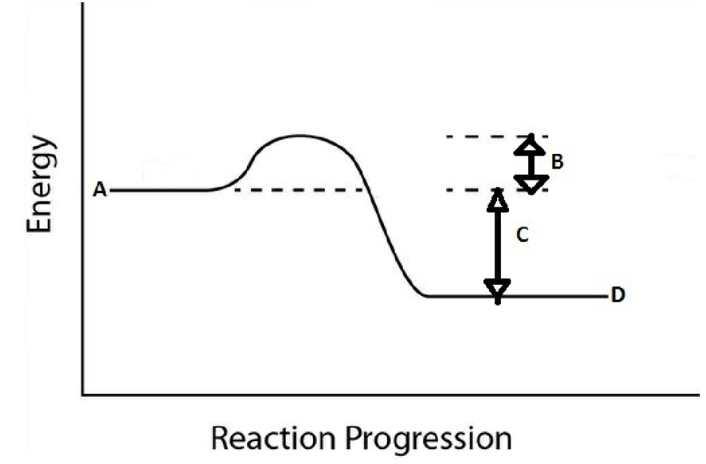
Letter B represents the activation energy
Students are observing the physical characteristics of live fruit flies, as shown in the diagram below.
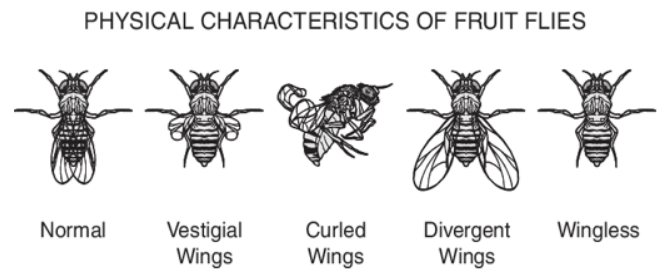
Which type of microscope would be best to use to observe the physical characteristics of living fruit flies?
A. light microscope
B. dissecting microscope
C. scanning tunneling microscope
D. transmission electron microscope
B. dissecting microscope
Louis Pasteur determined that microbes only appeared in sterile broth if the broth was exposed to the air. He concluded that the microbes were found in the air and contaminated the broth. Pasteur’s findings contributed to which part of the cell theory?
A. All animals are made of cells.
B. All cells come from preexisting cells.
C. The cell is the basic functional unit in living things.
D. Unicellular organisms inherit an exact copy of DNA from the parent cell.
B. All cells come from preexisting cells.
What is the function of the ribosome in a cell?
A. production of ATP
B. absorption of sunlight
C. site of protein synthesis
D. packaging proteins into membrane-bound vesicles
C. site of protein synthesis
Plant cells are different from animal cells. The diagram below identifies different structures in a plant cell.
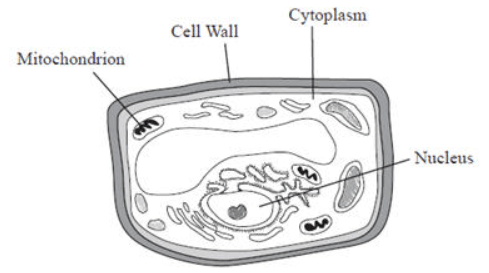
Which of the following structures are found in both plant and animal cells?
Cytoplasm, Nucleus, Mitochondrion
The equation below represents the process of photosynthesis.
6CO2 + 6H2O → C6H12O6 + 6O2
Based on this equation, what is the correct equation for cellular respiration?
A. 12O2 + C6H12O6 → 6CO2 + 6H2O
B. 6O2 + C6H12O6 → 6CO2 + 6H2O
C. 12CO2 + 6H2O → C6H12O6 + 6O2
D. 2CO2 + 6H2O → C6H12O6 + 6O2
B. 6O2 + C6H12O6 → 6CO2 + 6H2O
Which of these characteristics is NOT a property of water?
A. increases density as it solidifies
B. functions as a universal solvent
C. exhibits a highly cohesive behavior
D. moderates changes in temperature
A. Increases density as it solidifies
Water molecules freeze in a crystalline structure making it less dense than its liquid form.
Which macromolecule is digested in both the stomach and small intestines and is used by the body to repair and build cells and to create enzymes?
A. Lipids
B. Proteins
C. Carbohydrates
D. Nucleic Acids
B. Proteins
The graph below shows the rate of reaction versus enzyme concentration for a biochemical reaction.
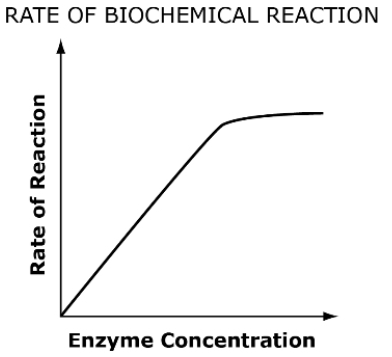
What is the best explanation of the relationship between rate of reaction and enzyme concentration?
A. At low enzyme concentrations, there is less competition for the enzyme active site, and the reaction rate is high.
B. As enzyme concentration decreases, the substrates will fill all available enzyme active sites, thus halting the reaction rate.
C. As enzyme concentration increases, there are more enzyme active sites available, and the reaction can proceed at a faster rate.
D. At high enzyme concentrations, there are many enzyme active sites that are not occupied by a substrate, so the reaction rate is slow.
C. As enzyme concentration increases, there are more enzyme active sites available, and the reaction can proceed at a faster rate.
Why would a scientist use a transmission electron microscope (TEM) instead of a compound microscope to view a tissue sample?
A. The TEM will produce an image with a higher resolution.
B. The TEM allows viewing of individual atoms.
C. The TEM image will be three-dimensional.
D. The TEM is used for live samples.
A. The TEM will produce an image with a higher resolution.
Which of the following statements about a plant cell is supported by the cell theory?
A. A plant cell has a cell wall made of cellulose.
B. A plant cell can divide to produce more plant cells.
C. A plant cell is able to metabolize carbohydrates for energy.
D. A plant cell can harness energy from the sun through photosynthesis.
B. A plant cell can divide to produce more plant cells.
Which organelle is responsible for controlling the passage of water, nutrients, and wastes into and out of the cell to maintain homeostasis?
A. Golgi apparatus
B. cell membrane
C. mitochondrion
D. ribosome
B. cell membrane
What is the difference between eukaryotic and prokaryotic cells?
A. The eukaryotic cells are found in bacteria and prokaryotic cells are not.
B. The prokaryotic cells are found in plants and animals and eukaryotic cells are not.
C. The eukaryotic cell contains DNA enclosed in a nucleus with organelles and prokaryotic cells do not.
D. The prokaryotic cell contains DNA enclosed in a nucleus with no organelles and eukaryotic cells do not.
C. The eukaryotic cell contains DNA enclosed in a nucleus with organelles and prokaryotic cells do not.
Photosynthesis is the process by which
A. the potential energy of simple sugars is transferred to ATP molecules
B. simple sugars are gradually broken down to form lactic acid or alcohol
C. two simple sugar molecules combine to form maltose and water
D. light energy is converted into the chemical energy of simple sugars
D. light energy is converted into the chemical energy of simple sugars
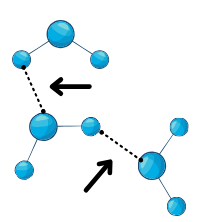 What are the bonds indicated by the arrows?
What are the bonds indicated by the arrows?
What elements of the water molecules do these bonds form between?
Hydrogen bonds
Hydrogen of one water molecule and the oxygen of another water molecule
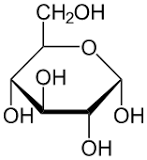 Function of the macromolecule pictured.
Function of the macromolecule pictured.
Quick energy
Multiple theories have been proposed about the origin of life on Earth. Which theory is most widely supported by scientists as an explanation of how life began on Earth?
A. Photosynthetic organisms developed after consumers.
B. Prokaryotic organisms evolved from eukaryotic organisms.
C. Organic molecules formed from common inorganic molecules.
D. Organisms developed first on land then moved into the oceans.
C. Organic molecules formed from common inorganic molecules.
The list below shows different types of microscopes.
- compound light microscope
- transmission electron microscope
- dissection microscope
Which description correctly identifies the type(s) of microscope(s) that require specimens to be non-living?
A. only compound light microscopes
B. only transmission electron microscopes
C. compound light and dissection microscopes
D. transmission electron and dissection microscopes
B. only transmission electron microscopes
What technology invention was the most beneficial for the development of the Cell Theory?
The microscope
Sea water is dangerous to drink because
A. sea water is hypotonic to your body tissues and will cause you to take in too much water.
B. sea water is hypertonic to your body tissues and drinking it will cause you to lose water.
C. sea water is isotonic to your body fluids and you will absorb too much water.
B. sea water is hypertonic to your body tissues and drinking it will cause you to lose water.
A student is using the Venn diagram shown below to compare structures in plant and animal cells.
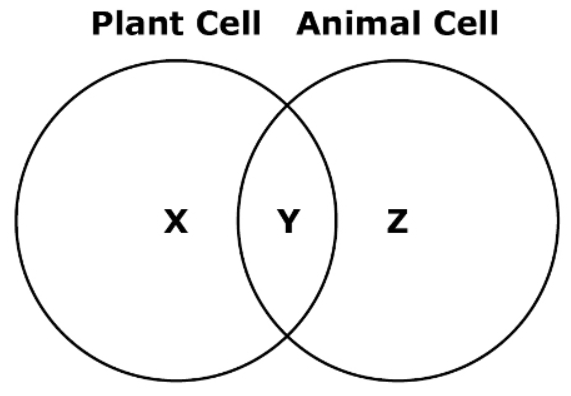
Which description correctly identifies X, Y, and Z?
A. X: lysosomes; Y: ribosomes; Z: chromosomes
B. X: mitochondria; Y: Golgi apparatus; Z: cytoplasm
C. X: chloroplasts; Y: cell membrane; Z: centrioles
D. X: endoplasmic reticulum; Y: cell wall; Z: nucleolus
C. X: chloroplasts; Y: cell membrane; Z: centrioles
The graphs below show the changes in the relative concentrations of two gases in the air surrounding a group of mice.
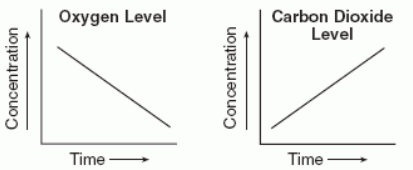
Which process in the mice most likely accounts for the changes shown?
A. active transport
B. evaporation
C. cellular respiration
D. photosynthesis
C. cellular respiration
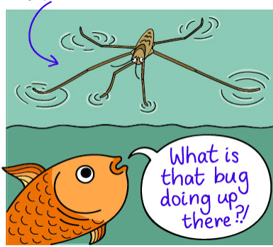 What property of water allows the water strider to walk on water?
What property of water allows the water strider to walk on water?
Surface Tension
which is caused by cohesion of water molecules
What is each macromolecule?
Molecule 1 Nucleic Acid
Molecule 2 Carbohydrates
Molecule 3 Lipids
Molecule 4 Protein
One of the accepted scientific theories describing the origin of life on Earth is known as chemical evolution. During chemical evolution, which of the following events would need to occur first for life to evolve?
A. onset of photosynthesis
B. origin of genetic material
C. synthesis of organic molecules
D. formation of the plasma membrane
C. synthesis of organic molecules
What is the difference between the scanning electron microscope and a transmission electron microscope?
Scanning electron microscope allows you to see the surface of cells and atoms.
Transmission electron microscope allows you to see inside of cells and atoms.
List all 3 parts of the Cell Theory
All living things are made of cell.
Cells are the basic unit of life.
All cells come from preexisting cells.
Flasks X, Y, and Z contain solutions with different concentrations of the solute NaCl.
– Flask X has 0.5% NaCl
– Flask Y has 0.9% NaCl
– Flask Z has 1.5% NaCl
Red blood cells (0.9% NaCl) will be placed into each flask. Predict what will happen to the blood cells in each of the flasks.
Flask X- swell
Flask Y- stay the same
Flask Z- shrink
Cell 1:
Lysosome
Ribosomes
Golgi apparatus
Nucleic acid with a nucleus
Cell 2:
Ribosomes
Nucleic acid without a nucleus
Cytoplasm
Cell wall
Cell 3:
Mitochondria
Cell Wall
Nucleic Acid with a nucleus
Chloroplast
Cell 1: Animal Cell
Cell 2: Prokaryotic Cell
Cell 3: Plant Cell
Energy to fill in the words missing at A, B and C.
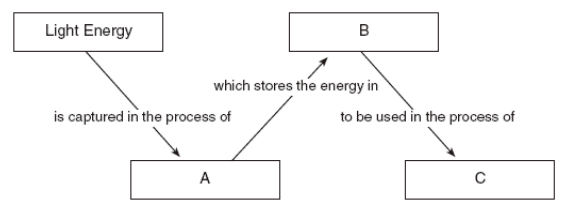
A- Photosynthesis
B- Glucose
C- Cellular Respiration